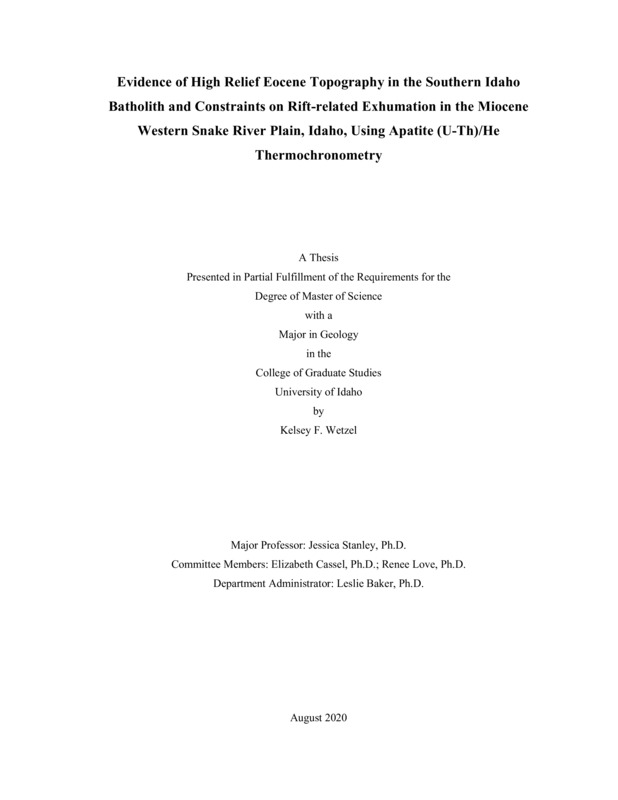Evidence of High Relief Eocene Topography in the Southern Idaho Batholith and Constraints on Rift-related Exhumation in the Miocene Western Snake River Plain, Idaho, Using Apatite (U-Th)/He Thermochronometry
Wetzel, Kelsey F. (2020-08). Evidence of High Relief Eocene Topography in the Southern Idaho Batholith and Constraints on Rift-related Exhumation in the Miocene Western Snake River Plain, Idaho, Using Apatite (U-Th)/He Thermochronometry. Theses and Dissertations Collection, University of Idaho Library Digital Collections. https://www.lib.uidaho.edu/digital/etd/items/wetzel_idaho_0089n_11932.html
- Title:
- Evidence of High Relief Eocene Topography in the Southern Idaho Batholith and Constraints on Rift-related Exhumation in the Miocene Western Snake River Plain, Idaho, Using Apatite (U-Th)/He Thermochronometry
- Author:
- Wetzel, Kelsey F
- ORCID:
- 0000-0001-6558-5458
- Date:
- 2020-08
- Keywords:
- Idaho Idaho batholith landscape evolution thermochronology western Snake River Plain
- Program:
- Geology
- Subject Category:
- Geology; Continental dynamics; Plate tectonics
- Abstract:
-
The western Snake River Plain (WSRP) in southwest Idaho has been characterized as an intracontinental rift basin but differs markedly in orientation and style from other western Cordilleran extensional structures. Understanding the rifting history of the WSRP and exhumation of its mountainous flanks can have implications for other intracontinental rift basins and for the topographic evolution of this region within the broader tectonic context. We sampled granitoid bedrock from Cretaceous and Eocene-aged plutons from the flanks of the WSRP to detail their exhumation history with apatite (U-Th)/He (AHe) thermochronometry. We present new AHe dates from seventeen samples, with cooling dates ranging from 7.9±1.4 Ma to 55±10 Ma. The majority of cooling dates for the Cretaceous plutons are Eocene, and the Eocene intrusions yield Miocene dates. The AHe dates provide thermochronological evidence of rapid cooling and exhumation of the Idaho batholith during the Eocene. This support the presence a high relief landscape in Idaho associated with regional uplift due to Farallon slab rollback and Challis magmatism. This high landscape was rapidly eroded and supplied massive amounts of sediment to Eocene basins across the Cordillera. We also find evidence for a post-Eocene decrease in relief, seen in the negative slope on date-elevation relationships in the southwest flank of the WSRP. Our AHe dates indicate limited exhumation on the flanks of the WSRP during Miocene rift formation. We interpret this to be evidence of extension dominated by magmatic intrusions and intrabasin faults rather than basin-bounding faults. Focused exhumation ~20-7 Ma seen in the Eocene pluton relates to concentrated incision along the Middle Fork Boise River in the interior of the Boise Mountains due to relative base level fall or more recent uplift due to plume-associated magmatism.
- Description:
- masters, M.S., Geology -- University of Idaho - College of Graduate Studies, 2020-08
- Major Professor:
- Stanley, Jessica R
- Committee:
- Cassel, Elizabeth J; Love, Renee L
- Defense Date:
- 2020-08
- Identifier:
- Wetzel_idaho_0089N_11932
- Type:
- Text
- Format Original:
- Format:
- application/pdf
- Rights:
- In Copyright - Educational Use Permitted. For more information, please contact University of Idaho Library Special Collections and Archives Department at libspec@uidaho.edu.
- Standardized Rights:
- http://rightsstatements.org/vocab/InC-EDU/1.0/

